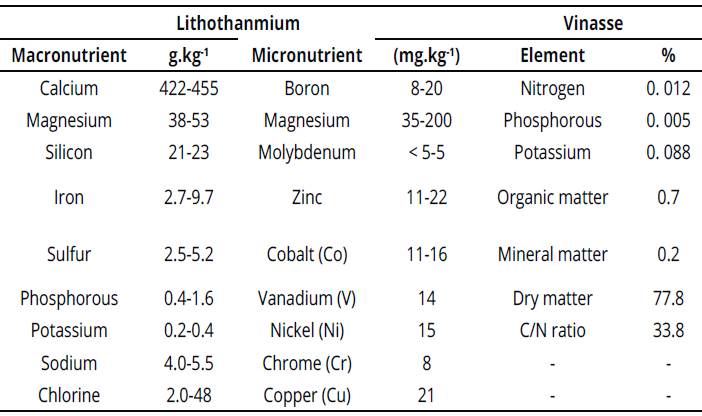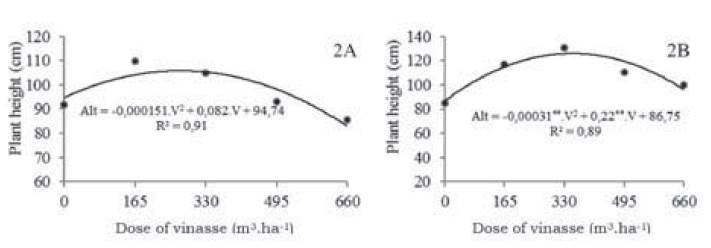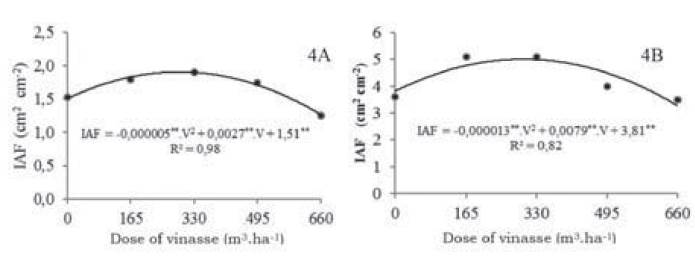Introduction
Sugarcane (Saccharum spp.) growth analysis and interaction conditions with environmental factors such as luminosity, temperature, CO2 concentration, availability of water and nutrients throughout the phenological cycle, is of remarked importance to establish plant growth efficiency and adaptation ability to a productive environment (Marafon, 2012). Studying the phenological behavior of this crop can help select cultural practices, such as better harvesting and sowing times, as well as identifying phenological phases in which plants demand more nutrients (Silva, Cunha, Texeira, Soares & Moura, 2015).
Moreover, lack of water and nutrients in phenological stages can significantly reduce production. According to Inman-Bamber and Smith (2005), water deficit limits leaf area expansion and the size of each leaf, due to abscisic acid production causing imbalance in normal plant development.
During the industrialization process, sugarcane generates byproducts such as bagasse, sludge, filter cake, vinasse, which can be used as alternative fertilization sources (Oliveira, Braga, Leonardo & Santos, 2014). These sugarcane byproducts needs to be combined with other sources of fertilizers to generate an increasing in crop production or an improvement in soil microbiological structure (González, Prado, Hernández, Caione & Selva, 2014).
One of the alternative sources that can be used in fertilization programs of this crop is vinasse. Vinasse is a residue of the production process of alcohol, which is rich in organic matter and potassium, which offers great possibilities for its rational and economic incorporation in sugarcane, as long as the correct dose at the appropriate time is used (Neto, Figueredo, Farias, Azevedo & Azevedo, 2006). In association with vinasse, another source that can be used is lithothanmium. This product is derived from the calcareous marine algae Lithothamnium calcareum, which shows in its chemical composition several macro-and micro-nutrients, which favors soil fertility conditions and/or potentiates the use of other fertilizers due to its corrective action on acidity (Evangelista, Alves, Casaroli & Resende, 2015). Lithothanmium has successfully used for the production of fruit plant nurseries but currently, little known about how it works in sugarcane fertilization (Hafle, Andrade, Ramos, Monterio & Melo, 2009). Correct fertilization in initial development stages of sugarcane crop, together with a correct irrigation management can have an excellent return by significantly increasing plant growth and development, as well as improvement in crop quality and productivity. The study starts from the hypothesis that the use of full irrigation, associated with different doses of vinasse and lithothanmium is a viable production alternative in sugarcane produced under an organic production system. Given these concerns, the aim of this study was to evaluate the effect of irrigation and different doses of lithothothanmium and vinasse fertilizer on sugarcane (Saccharum sp. cv. RB 86-7515) initial growth.
Material and methods
This study was carried out in the experimental area of the School of Agronomy, at Universidade Federal de Goiás (UFG), Brazil and the sugarcane cv. RB 86-7515 was used.
To conduct the experiment, 150 plastic containers of 200 liters were used, with spacing of 1.50 m between lines. The statistical delineation was a completely randomized design with three replicates, in a factorial scheme (5 x 5 x 2). Treatments correspond to five doses of vinasse (0, 165, 330, 495 and 660 m3.ha-1) and five doses of lithothanmium (0, 100, 200, 300 and 400 kg.ha-1) in two environments: irrigated and not irrigated. The maximum dose of vinasse (660 m3.ha-1) was established according to the technical standard P4.231, December 2006 of the Technology and Environmental Sanitation Company (Klein, Filho & Almeida, 2008). Containers were filled with soil extracted from approximately two meters of depth, from a construction area that was never used for agriculture, and was classified as Latossolo Vermelho Amarelo [Red Yellow] with a sandy texture (Embrapa, 2006). To facilitate water drainage a layer of 0.10 m of gravel was placed in the bottom of containers.
Doses of lithothanmium were manually applied during planting and doses of vinasse were divided according to the rate in which potassium was absorbed by the crop (Bachchhav, 2005). Furthermore, the chemical composition of lithothanmium and vinasse are shown in Table 1.
The irrigation system used was located with an emitter in each barrel with a flow rate of 4.0 L.h-1. Irrigation management was carried out by monitoring soil humidity by means of watermark sensors, and irrigation layers were calculated in such a way that the amount of water applied increased the humidity to field capacity.
Biometric evaluations were made of plant height, number of buds per linear meter, corm diameter, and leaf area index. Evaluations on sugarcane plants were made at 150, 240, 360 and 450 days after planting, corresponding with tillering stage (phase I), initial growth (phase II), intermediate development (phase III) and final growth (phase IV) (Diola & Santos, 2012). For plant height, leaf area (AF) and leaf area index evaluation, the methodology published by Marafon (2012) was used. Variables under evaluation were subjected to analysis of variance. To identify significant difference among treatments and statistical significance for all comparisons was made at p<0.05. Tukey's multiple range test was used to compare the mean values of treatments, which was carried out for irrigation treatments and fertilizer doses, as well as polynomial regression analyzes.
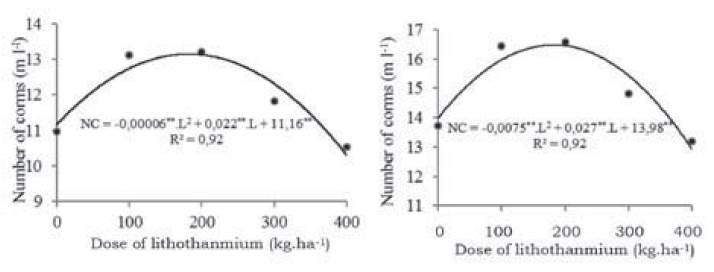
Figure 1 Effect of different doses of lithothanmium on number of corms per linear meter 150 and 240 days after planting
In Phase I, the maximum height (106 cm) is reached when sugarcane plants were irrigated and fertilized with 200 kg.ha-1 of lithothanmium and 270.63 m3.ha-1 of vinasse (Figure 2A). Meanwhile in Phase II, the maximum height (126 cm) is reached with 200 kg.ha-1 of lithothanmium and 351.76 m3.ha-1 of vinasse (Figure 2B). With doses of vinasse higher than 300 m3.ha-1 plant growth decreases exponentially.
Results
Phase I and II
In phase I, an independent significant effect was confirmed from vinasse doses, lithothanmium and irrigation, for the number of corms and leaf area index. For plant height and corm diameter, interaction of the three evaluation factors was verified.
In Phase II, irrigation management and vinasse doses caused a significant independent effect on the number of corms. Vinasse dose and lithothanmium influenced corm diameter. Finally, plant height and leaf area index were influenced by all evaluation factors.
Results indicate a direct relationship between doses of organic fertilizer and irrigation on tillering phase and initial growth. Between phase I (Figure 1A) and phase II (Figure 1B), there was an increasing of 23 % in the number of corms per linear meter in sugarcane plants that were fertilized with 181.72 kg.ha-1 of lithothanmium.
Moreover, largest corm diameter (23.52 mm) at 150 DAP (Figure 3A), was reached with plants irrigated and fertilized with 159.42 kg.ha-1 of lithothanmium and 330 m3.ha-1 vinasse. Doses of lithothanmium higher than 200 kg.ha-1 caused a decrease in plant diameter. While in Phase II, maximum corm diameter (23.66 mm) was reached in plants fertilized with 197.72 kg.ha-1 of lithothanmium (Figure 3B). Maximum LAI (1.91 m2.m-2) in Phase I (Figure 4A) is reached with irrigated and fertilized plants with 291.63 m3.ha-1 of vinasse. While in Phase II (5.02 m2.m-2), it is reached when plants are irrigated and fertilized with 305.62 m3.ha-1 of vinasse and 200 kg.ha-1 of lithothanmium (Figure 4B). When comparing the difference between phase I and phase II plants increased 162% in leaf area.
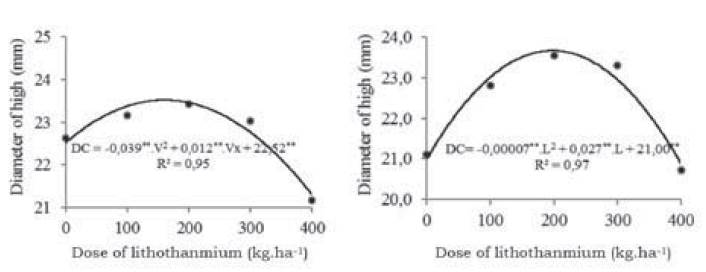
Figure 3 Effect of different doses of lithothanmium and 330 m3.ha-1 of vinasse on corm diameter irrigated 150 and 240 days after planting
Phase III and IV
Corm number in phase III was influenced by all variation factors considered. While in phase IV, the doses of vinasse and irrigation caused a significant effect in this same variable. For plant height (phase III), a significant effect was found for irrigation management, while in phase IV, interaction between the three variation factors was verified.
In relation to corm diameter, triple interaction was verified in both phenological phases. Finally, IAF in phase III was influenced by irrigation management, and in phase IV, by doses of vinasse, lithothanmium and irrigation.
Discussion
Results indicate a direct relationship between the doses of organic fertilizer and irrigation management on the phase of tillering and initial growth of sugarcane. Between phase I (Figure 1A) and phase II (Figure 1B), there was an increasing of 23 % in the number of corms per linear meter, in plants that were fertilized with 181.72 kg.ha-1 of lithothanmium. Results in this phase are similar to those found by Oliveira et al. (2014), where the authors found 17 corms per lineal meter in irrigated sugarcane and without water restriction for the same cultivar. This behavior is probably due to water availability and the effect of lithothanmium, since it potentiates potassium uptake, intensifying the appearance of number of corms per linear meter (Evangelista, Evangelista, Vieira & Júnior, 2016). The positive effect of lithothanmium application can be attributed to the presence of neutral calcium with formation of chelates contributing to greater plant uptake (Evangelista et al., 2015). While irrigation probably favored the movement of this nutrient as the soil remained close to field capacity, this caused evapotranspiration rate to be maximum, stimulating nutrient translocation in relation to sugarcane plants that did not receive water. This condition probably maintained cell turgor and growth continuity, expansion, cell division and photosynthesis in irrigated plants (Inman-Bamber & Smith, 2005).
Doses greater than 200 kg.ha-1 oflithothanmium cause a decreasing in number of buds; this effect is probably justified because in this phenological stage, the root system of the plant is poorly developed, which makes it impossible to absorb nutrients in large quantities. In addition to this, lithothanmium is a rapid release product and in high doses causes, that is, in doses greater than 300 m3.ha-1 of vinasse, plants growth decreases exponentially. Excessive vinasse application in soil during tillering and in the initial growth phase causes nutrient leaching; this is in addition to salinization, due to salt concentrations that appear because of mineral excess, which can cause cationic imbalance. Therefore, this is why Silva, Griebeler & Borges (2007), have always recommended that fertilization should be parceled and controlled.
Furthermore, largest corm diameter (23.52 mm) at 150 DAP (Figure 3A), is reached with plants irrigated and fertilized with 159.42 kg.ha-1 of lithothanmium and 330 m3.ha-1 of vinasse. Doses higher than 200 kg.ha-1 of lithothanmium cause decreases in plant diameter.
Moreover, reduction in corm diameter probably occurs due to reduction in number of plants as a consequence of high population competition in this phase. As for the influence of lithothanmium it could have been damaged because it is a rapid release product and causes depressive effect in plants, especially in soils with base saturations above 70%; this is because it increases soil pH and inhibits nutrient uptake (Evangelista et al., 2016). Maximum LAI (1.91 m2.m-2) in Phase I (Figure 4A) is reached with irrigated and fertilized plants with 291.63 m3.ha-1 of vinasse. While in Phase II (5.02 m2.m-2), it is reached when plants are irrigated and fertilized with 305.62 m3.ha-1 of vinasse and 200 kg.ha-1 of lithothanmium (Figure 4B).
Physiological behavior of IAF is due to the fact that after the root system is developed, the plant goes through a linear growth phase with a higher dry matter rate increase. Moreover, leaves gradually become self-shading increasing leaf area index, although this does not always mean a higher phytomass increase (Marafon, 2012). The positive effect of the initial growth in sugarcane is probably due to water availability. In addition, presence of potassium probably favors metabolic plant processes, since it participates in osmotic regulation and in stomatal opening and closing, a fundamental process in CO2 uptake (Almeida Júnior, Nascimento, Sobral, Silva & Gomes, 2011; Almeida, Souza, Teodoro, Barbosa, Moura & Ferreira, 2008). Meanwhile, lithothanmium is favored in ion movement as the calcium present in this fertilizer is highly soluble and with a great capacity to form chelates, increasing its ionization power in the soil solution (Melo, Mendonça, Moura, Lombardi, Ferreira & Nery, 2006).
Phase III and IV
The maximum number of corms per linear meter in both phases is reached with irrigated and fertilized plants with 311 m3.ha-1 of vinasse, although a decrease of 13 % in the number of corms in phase II was found. However, a decrease in the number of corms is justified because the plant suffers bud selection by self-shading, causing the death of the weakest buds (Segato, Mattiuz & Mozambani, 2006). From this phenological phase, number of corms stabilized causing an increasing in the average plant height of sugarcane plants that received irrigation.
Furthermore, in relation to plant height in phase III, plants responded significantly to irrigation management, while in phase IV all evaluation factors showed significant effect.
According to Machado, Ribeiro, Eduardo, Machado, Machado & Landell (2009), adequate water availability in initial growth stages reduces significantly losses and provides favorable conditions for vegetative plant growth. This fact justifies the results found by Silva et al. (2015), who confirmed that a significant increasing in sugarcane productivity is found with irrigation in comparison to what was produced without irrigation.
In relation to corm diameter in phase III (Figure 5), the largest diameter (26.04 mm) is reached in irrigated sugarcane plants and fertilized with 200 kg.ha-1 of lithothanmium and 372 m3.ha-1 of vinasse. While in phase IV, the largest diameter is reached with irrigated and fertilized plants with 208.7 kg.ha-1 of lithothanmium and 165 m3.ha-1 of vinasse, that on average reached 28.28 millimeters.
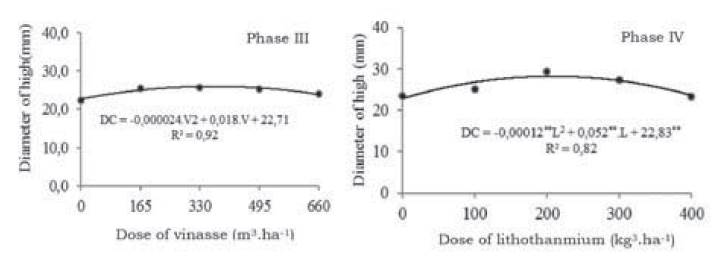
Figure 5 Effect of different doses of vinasse and lithothanmium on sugarcane diameter irrigated at 360 and 450 days after planting
This behavior is probably due to the fact that young corms do not resist higher nutrient doses which causes their death and potentiates growth of older buds. In relation to a decrease in the growth of plants with doses higher than 200 kg.ha-1 of lithothanmium and 330 m3.ha-1 of vinasse; Silva, Jeronimo & Dalcol (2008), warns that when vinasse is applied in high doses, can cause undesirable effects such as compromising sugarcane quality for sugar production, soil salinization and groundwater contamination.













